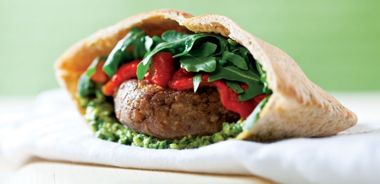Lentil Quinoa Burgers with Hemp Pesto

These veggie burgers are crammed with fibre to keep you feeling full. The flavourful pesto also makes a great spread for sandwiches.
1 cup (250 mL) dried green or brown lentils
1/2 cup (125 mL) quinoa
1 cup (250 mL) cilantro, packed
1/3 cup (80 mL) hempseeds
1/3 cup (80 mL) Parmesan cheese, grated
Juice of 1 lemon
4 cloves garlic, chopped
1/4 tsp (1 mL) salt
1/4 cup (60 mL) hemp oil
1/2 cup (125 mL) bread crumbs
1 large egg
1 Tbsp (15 mL) Dijon mustard
1 tsp (5 mL) cumin powder
Salt and pepper to taste
1/3 cup (80 mL) walnut pieces
1 Tbsp (15 mL) vegetable oil, such as grapeseed oil
4 whole wheat pitas, sliced in half
2 cups (500 mL) arugula
1 cup (250 mL) roasted red peppers, sliced (use store-bought or roast your own; see below)
In medium saucepan, bring lentils and 2 1/2 cups water to a boil. Reduce heat to medium-low and simmer for 35 minutes, or until tender. Remove from heat and let cool.
In separate small saucepan, combine quinoa and 1 cup (250 mL) water. Bring to a boil; reduce heat and simmer until water is absorbed, about 10 minutes. Let cool.
Meanwhile, in bowl of food processor pulse together cilantro, hempseeds, Parmesan, juice of 1/2 lemon, 2 garlic cloves, and salt. Scrape down sides of bowl. With the machine running, pour in hemp oil through the feed tube and process until mixture is well combined but still grainy. Remove pesto and clean food processor bowl.
Add half of lentils to food processor bowl along with quinoa, bread crumbs, egg, 2 garlic cloves, mustard, cumin, remaining lemon juice, and salt and pepper to taste. Process until well combined, scraping down sides if needed. Add walnuts and remaining lentils; pulse or mix with fork until they are incorporated into the mixture. Form into 8 equal-sized burgers.
Heat vegetable oil in skillet over medium heat. Cook lentil burgers for 3 to 4 minutes per side or until browned. Spread hemp pesto on the inside bottom of pitas. Place burgers in pitas and top with arugula and roasted red pepper.
Serves 6.
Each serving contains: 460 calories; 23 g protein; 20 g total fat (3 g sat. fat, 0 g trans fat); 52 g carbohydrates; 14 g fibre; 393 mg sodium
How to roast red peppers
Preheat broiler on low. Wash peppers and pat dry; place on metal baking sheet. Keep a close eye on peppers, turning several times to ensure even blistering. Make sure they don’t turn black! Remove from oven and place peppers in paper bag to cool. When cool, remove and discard skin, which should come off easily.
source: "Hooray for Hemp", alive #343, May 2011





